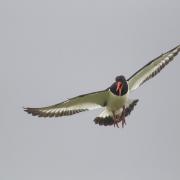Paul Hobson extols the virtues of a fine month to discover ‘splendour in the grass, glory in the flower’ (courtesy of William Wordsworth)

June is the month with the most daylight hours of the year (in the northern hemisphere) and is named after the Roman god Juno. I also like to think it is the month when the insect world literally explodes into the countryside.
Many butterfly species (such as the lovely brown argus) are now fluttering their dazzling wings across moorland, woodland and flower-rich meadows. Our ponds – both in the higher moorlands as well as in the species-richer lowlands – are now frequented by damsel and dragonflies. While under the surface of these ponds and lakes many a drama is being played out by beetles, water boatmen and small fish.
The majority of Derbyshire’s birds are now fully engaged in either building nests, laying eggs or rearing lusty young. One bird, however, will have successfully managed to bypass two of these onerous tasks – those of building a nest and feeding its young. Everyone is familiar with the cuckoo. Its name holds so many connotations in our language, yet surprisingly few people have ever seen one, and every year there seem to be fewer who get to listen to what is surely an iconic summer bird.
Cuckoos were once common across the majority of Derbyshire’s moors and farms, yet over the last 30 years they have suffered a dramatic decline for which we are all the poorer. We think of cuckoos as British birds yet they are African birds that spend a short three months with us every summer before returning to their warmer winter quarters. Everyone knows about the cuckoo’s parasitic breeding strategy of laying its eggs in the nest of a host species such as a meadow pipit or reed warbler. The strategy seems underhand yet in evolutionary terms it is successful – though clearly one that few birds could adopt!

June is probably the best month in Derbyshire to look for orchids. A few early purples may still be out but the most intriguing orchid of early June is the diminutive, yet stunning, fly orchid. These can be difficult to spot until you get your eye in but once seen they are never forgotten. A couple of Derbyshire Wildlife Trust reserves have reliable colonies of these little beauties, so if you want to test your eyes join them and ask about access.
Later in the month, and spilling into early July, the equally fabulous bee orchid will be showing its lovely flowers at many locations across the county. Bee orchids like their soil poor in quality so reclaimed coal pits and limestone quarries (such as those at Pleasley Pits and Miller’s Dale) are ideal places to look for them.
If you want to search out something a little larger and arguably more showy, then June is the month to search for our blue beauty, Jacob’s ladder, Derbyshire’s county flower. The top end of Lathkill Dale is always a good place to start looking and whilst you are scanning the rocky valley bottom you should be serenaded by the resident redstarts, garden warblers and jackdaws.
June is the first month when Derbyshire’s wildlife watchers can start to find a number of early summer dragonflies on the wing. It is true that some, such as the broad-bodied and four-spotted chasers, will have been flying on warm days in late May but by June their numbers will be reaching their zenith.

Many of the dew ponds around the limestone dales are excellent sites for broad-bodied chasers, particularly if they still hold water and have good pond weed. The name says it all really as both the blue male and brown female have delightfully short and chunky bodies. If you can spend a few hours around the ponds on a sunny day you may be able to watch the many skirmishes the males have with each other and the rapid aerial mating as a male grips onto his consort. When she is ready to lay eggs she will fly across the pond, occasionally dipping her abdomen into the water as she expertly navigates her way to and fro across the pond’s surface.
If, however, you want to watch both broad-bodied and four-spot chasers then one of the best places is Pleasley Pits on the edge of the county towards Mansfield. The ponds here offer the ideal conditions for both species, and once you have had your fill of these magical mini-beasts you can retire to the excellent café for a sausage butty before heading back out to search for bee orchids.
Juno’s month offers so much to the wildlife watcher with birds, butterflies, dragons and orchids that it is difficult to stay indoors when the sun shines, the birds sing and insect wings rustle. It is also the first month when the long evenings allow us to explore our superb wildlife after work and there is no better way to unwind and relax than to lie down in a flower-rich meadow and let the natural world calm your jaded nerves.





























